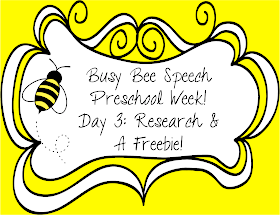As you probably know, evidence based practice (EBP) is a requirement for all SLPs. In other words, we all gotta make sure our therapy techniques are backed up by research! Let's look at 2 research based therapy activities that should help your preschoolers - one for speech and one for language.
1. Using tactile/touch cues with kids who exhibit articulation deficits
Touch cue techniques such as PROMPT (Prompts for Restructuring Oral Muscular Phonetic Targets) have been proven successful in those that exhibit phonological disorders, motor speech disorders, and even childhood apraxia of speech. PROMPT is a multi-dimensional approach that focuses on the use of touch cues to a child's articulators that help them through the production of a word.
 |
| source |
Well, Joy showed me how to incorporate tactile cuing during play. We touched the places where their little articulators would go for that extra measure of cuing. For example, if they were to produce "mat," we pushed their lips together for the /m/ (like in the pic) and then touched right above the upper lip for the /t/. I found this very effective for these types of kids.
The PROMPT website has an entire research page to back up their cuing technique. You can find it HERE. Their research projects are pretty specific to the PROMPT program.
More generalized research for simply using tactile cues can be found here and here.
I've also heard that Speech Buddies provide great tactile cues as well. I haven't had the opportunity to use these, but maybe some of you have! Here are some stats for using these in therapy. :)
2. Play-based language therapy
I'll bet the majority of you that work with preschoolers utilize some form of play-based therapy. It's a technique I learned in school, and I'm sure many of you did as well. I guess I never really paid attention to whether or not it was research based, but guess what? It definitely is! AND it has proven to be effective across a variety of disorders such as language delays, autism, cleft palate, and more.
 |
| source |
I thought I'd share a few ways I incorporate play into my language therapy:
- Vocabulary building - Toys are a great way to increase those vocabulary skills. Some of my favorite vocab toys are potato heads (body parts and clothing), play doh (colors and shapes), puzzles, and memory matching.
- Pretend play - This is another great way to build vocabulary, verbal routines, requesting, action words, descriptive words, and the list goes on and on. A few of my favorite toys for this are plastic animals and farm sets, plastic food, doll houses, and car sets. Seriously, you can get SO much out of a kid when you speak their language - playing!
- Gross motor toys - Some kids just need to get up and move. I have some little boys now that can barely sit still long enough to play with "table" toys. Gross motor toys are great for requesting, prepositions, action words, and descriptive words. I love balls, bubbles, and balloons for this.
- Fishing - Pretty much the only way I can engage my preschoolers in cards is through fishing. It's pretty simple to attach paper clips to the cards and a magnet to a stick with a string. This way I can target whatever card decks or TPT activity I printed.
And in case you need that research to back up your EBP, here are a few articles for you to check out!
Don't forget when implementing EPB, you do take into account research findings, but you also have to look at your own clinical experiences as well as the specific needs of the client. All 3 play a role in EBP. :)
And last but certainly not least, here is a fun FREEBIE for you! It's just in time for Valentine's Day. :)
It's a cute little love bug Valentine game that targets bilabials and alveolars. Maybe you can put those tactile cues to practice. ;) It even includes some blank cards in case you want to add your own spin to it! Hope you enjoy! Download it here.
Graphics by MareeTrueLove





Loving your Preschool Week posts!!
ReplyDeleteThanks, Monica! I'm so glad they've been useful for you :)
DeleteI agree with Monica! I'm already looking forward to tomorrow's! :)
ReplyDeleteThanks so much! Hope you enjoy! :)
DeleteAlways love your materials and insights. I haven't been trained in PROMPT, but am very familiar with cueing strategies a la "Moving Across Syllables," etc.
ReplyDelete(Trying to take Speech2U's lead and not "blog stalk" :-)
Thank you annied! I haven't heard of "Moving Across Syllables" but I may have to check that out. :)
Delete